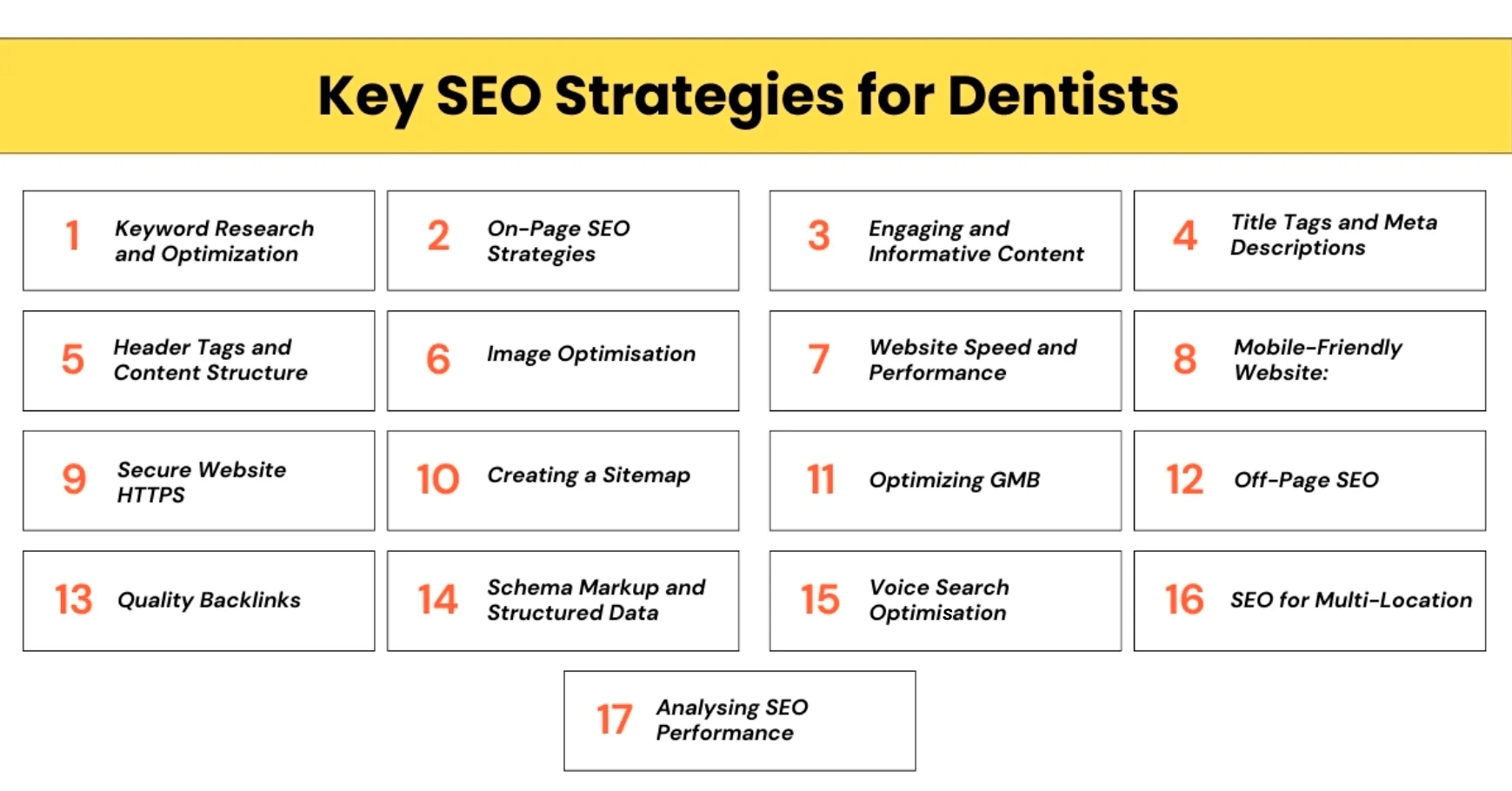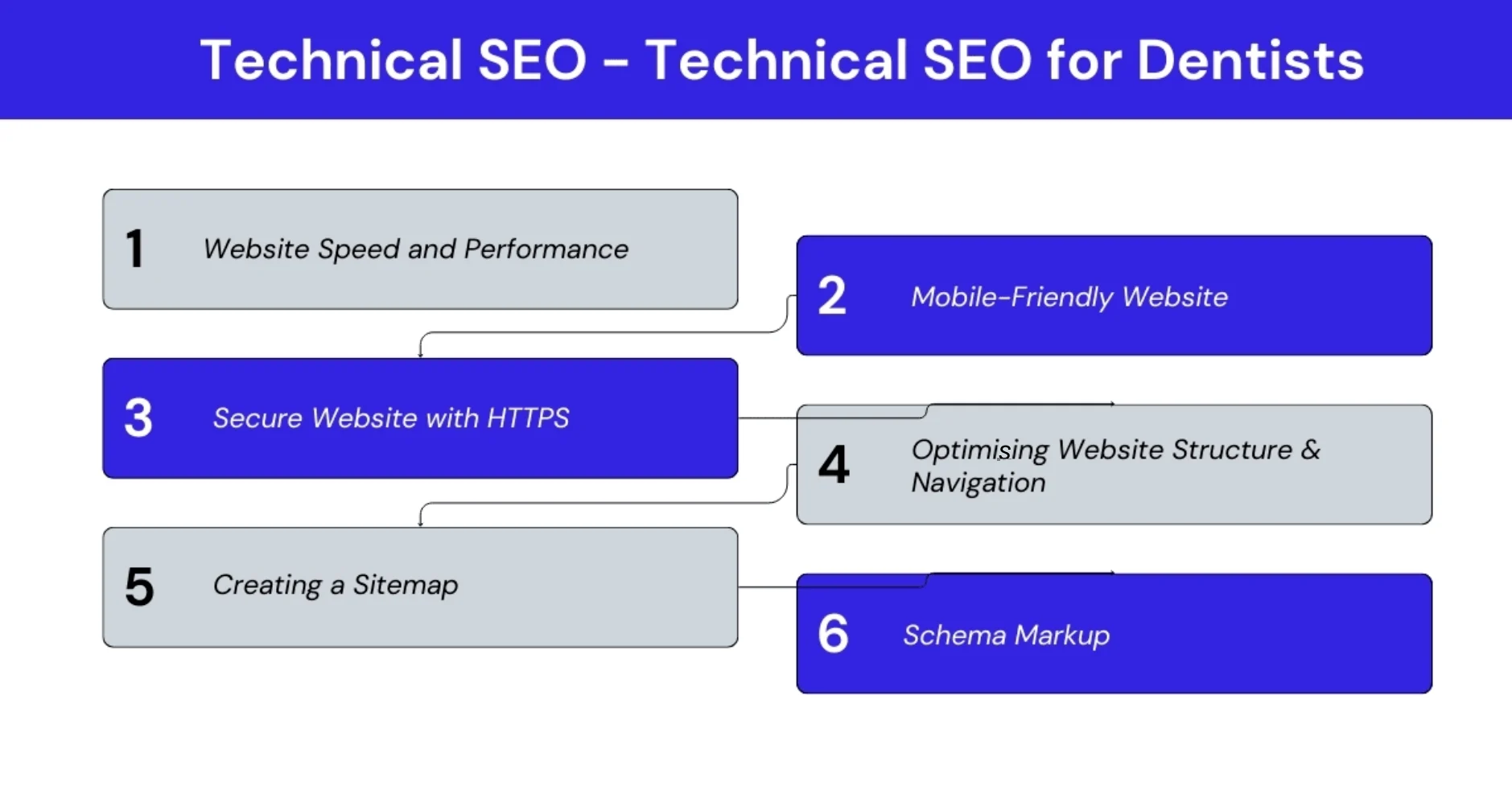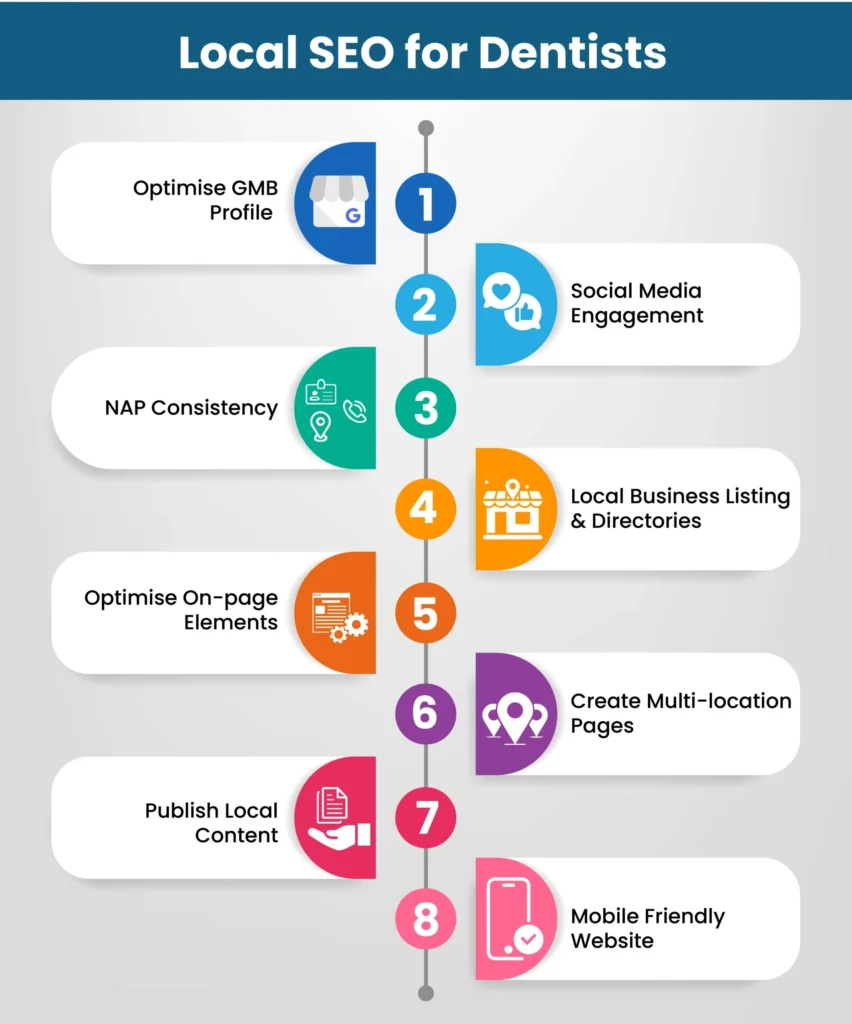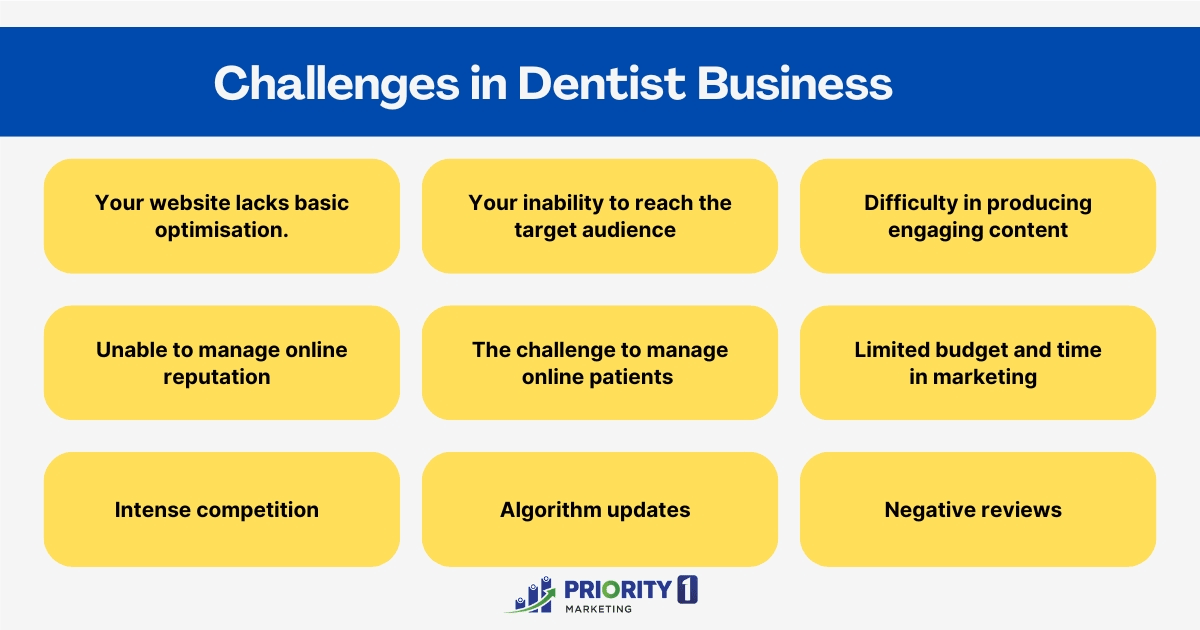
Search engine optimisation is a significant player in ensuring a business’s presence is amplified in today’s digital marketing arena. According to the SEO Tribunal, 97% discover a local business online than anywhere else. Dental practice SEO is a process to make your website more visible to prospective local patients seeking services related to dentistry.
In today’s digital landscape, having a robust online presence is essential for any business, including dental practices. Search Engine Optimisation (SEO) plays a crucial role in ensuring that your dental practice can be found by potential patients searching for dental services online. In Australia, where the competition among dentists is fierce, implementing effective SEO strategies is vital to stand out and attract more patients. This comprehensive guide will walk you through everything you need to know about SEO for dentists, from the basics to advanced techniques tailored for the Australian market.
Challenges in Dentist Business
Market Research and Statistics on the Australian Dental Industry
To effectively implement SEO strategies for dentists in Australia, it’s important to understand the current state of the dental industry.
1. Market Size and Growth
The Australian dental services market is projected to grow at a compound annual growth rate (CAGR) of 2.5% from 2021 to 2026, reaching approximately AUD 11 billion by 2026. This growth is driven by increasing awareness of oral health, a growing population, and higher demand for cosmetic dental procedures.
2. Competitive Landscape
The dental industry in Australia is highly competitive, with over 16,000 registered dentists as of 2023. Practices must differentiate themselves through specialised services, patient care, and online presence to stay competitive.
3. Patient Behavior
According to a survey conducted by the Australian Dental Association, nearly 65% of Australians regularly search online for dental services, with a significant portion using search engines like Google to find nearby dentists. This highlights the importance of a strong online presence for attracting new patients.
4. Regional Differences
SEO strategies may need to be tailored to different regions in Australia. For instance, practices in major cities like Sydney and Melbourne face more competition and may need to focus heavily on local SEO, while those in regional areas might benefit from broader keyword strategies.
The dentistry landscape is fast evolving due to digital marketing developments. You cannot solely depend on traditional marketing and word-of-mouth referrals. An optimised online presence is no longer an option but a necessity for dentist businesses. Let’s now understand the challenges dentists face in their business.
Today, it is a significant challenge for your dentist business if you ignore your presence online–it could be a website or social media. Statista says 50% of smartphone users browse a site on their mobile browser. A Deloitte survey reports that approximately 90% of Australians use smartphones daily to play, work, and interact with friends and family. Patients consistently search for dental businesses online.
- Your website lacks basic optimisation.
- Your inability to reach the target audience
- Difficulty in producing engaging content
- Unable to manage online reputation
- The challenge to manage online patients
- Limited budget and time in marketing
- Intense competition
- Algorithm updates
- Negative reviews
Understanding the Basics of SEO for Dentists
What is SEO?
SEO is the vital approach that dentist businesses need to take to enhance their search engine visibility strategically. You don’t just seek high ranking on Google search but also understand why you are ranking and taking your presence to the right audience. Dental SEO is how your dental business will appear high on search engine results. You can achieve the top place on the search engine result page without running ads.
How Search Engines Work: Google’s Algorithm Explained
Google uses complex algorithms to determine which websites to display at the top of search results. These algorithms consider various factors, including the relevance and quality of your content, the user experience on your website, and the number of other websites linking to your pages.
The Role of SEO in Building an Online Presence
SEO is essential for dentists as it increases searchability and visibility in search results. You can effectively draw new patients to your practice. So, it would be best if you incorporated SEO in your dentist business for several reasons:
- Boost business visibility and branding
- Cost-effective marketing strategy
- Increases organic traffic
- Enhances brand credibility
- Engage local seekers
- Achieve better conversion rates
- Better your competition
- Optimises your user experience
- Long-term strategy with best results
- Gain insight into your customers
With raging competition among dentists’ businesses, your digital presence can set you apart and ahead in this digital race. SEO helps you to channel organic, relevant traffic to your dental business website.
Why Dentists Need SEO
If you own a dentist business in Australia, you will understand how competitive the local market is. To stand out, you need to do something out of the box.
You need to understand that dental businesses are quite like e-commerce websites. Your target audience will be within a particular proximity. SEO-specific benefits for dentist businesses are crucial as they give a unique edge.
- Informed Decisions – Today, you cannot undermine patients. Before zeroing in on a dentist, they look at reviews, services, and premium offerings.
- Localised Searches – You can optimise your content for local searches to have a higher chance of visibility
- Content Marketing – Write helpful blogs on oral hygiene and specific treatments to help you establish your business as a thought leader.
- Personalised Patient Experience – Take advantage of key metrics related to your target audience and produce content that can offer a personalised experience.
Key SEO Strategies for Dentists
It would help if you worked towards growing your dentist business and attracting more patients. To do that, you can use SEO for dentists that is firmly built on the vital core of regular SEO. It focuses on driving traffic to the website in the local neighbourhood.

Keyword Research and Optimisation
Keyword research is a huge part of search engine optimisation, since it allows one to see what people are typing or speaking into the Google search box to find one’s business, subject matter, or expertise. What follows herein is a general overview of why keyword research is so important and includes some tools one may find useful.
Identifying Relevant Keywords
Understanding Your Audience: Keywords will help you truly understand the language of your audience and what they are searching for.
Relevance of Content: They ensure what’s inside your content is relevant to what people are searching for. In this way, you have the maximum chances that your content will end up on SERPs.
Driving Traffic: Targeted keywords, when appropriately targeted, can really help drive organic traffic toward a website and reach an audience at the right moment, hopefully to convert.
Tools for Effective Keyword Research in the Dental Industry
These tools allow you to see how often certain keywords are searched and how difficult it is to rank for them. Focus on long-tail keywords like “affordable dentist in Sydney” or “emergency dental care in Melbourne,” which are more specific and often less competitive.
Some of the most common keyword research tools used include:
Google Keyword Planner – A free tool linked to a Google Ads account, which provides data on search volume, competition, and trends for the keywords.
Ahrefs – It’s popular for having a large database and provides keyword suggestions for competition, and an overview for the SERP.
Ubersuggest – A free tool used for keyword ideas extracted from Google’s popular autocomplete series. It also shows the search volume and competition for these ideas, including seasonal trends.
KWFinder – This is an easy-to-use tool for finding long-tail keywords with less competition, and it provides data on search trends.
AnswerThePublic – Questions people ask in its search are turned into a search image for suggested autocompleting queries; it is in image form called a search cloud.
Analysing Competitor Keywords
One strategic way to get an inside view into the SEO landscape to improve your website’s performance is analysing competitor keywords. Here’s how you can identify competitor keywords and some of the tools that can help with competitive analysis:
To identify your competitors; First off, identify who your direct search competitors are; they may be slightly different from your business competitors. Identify the keywords using SEO tools for which the competitors rank.
On-Page SEO Strategies
On-page SEO is a part of digital marketing that deals with optimising several elements on your website to achieve improved visibility and higher ranking on search engines. Some strategies for website content optimisation are discussed below.
Writing Engaging and Informative Content
The content that you put up should offer value to the readers, be well-researched, and cover the topic comprehensively. You know what they are looking for and design content accordingly. It also helps to create fresh and virgin, with completely new information and insight viewers can’t otherwise find.
Use of Multimedia (Images, Videos): Visually Appealing: Add images and videos to create interest, breaking up large sections of text.
SEO Optimisation: Use descriptive file names and alt text for images so search engines are better at understanding the content.
User Experience: Rich media creates a better user experience, giving visual expression to content that can lead to longer dwell times and lower bounces rates.
Putting these on-page SEO strategies to work can greatly enhance the performance of your website content, increasing the likelihood of high search engine rankings and more visitors. Always be aware that user experience should come first in any content creation effort.
Title Tags and Meta Descriptions
Title tags and meta descriptions are crucial elements of on-page SEO, serving as the first point of interaction with users on search engine results pages. Here’s how to craft them effectively:
Title Tags:
- Not more than 50-60 characters.
- Primary keywords should be on top.
- Start unique and descriptive with no duplicates
- Aim for relevance and clickability.
Meta Descriptions:
- Complementing the title tag with additional context,
- Respond to what a user’s search intent.
- Write in active voice.
- Within 155-160 characters.
Both title tags and meta descriptions should be compelling to result in better click-through rates. This may not improve rankings directly but keep testing and monitoring regularly for optimising the performance.
Header Tags and Content Structure
Header tags, along with your content structure, are very important in terms of SEO and User Experience.
Header Tags:
H1 Tags should be the main title of a page and should be used for the big headline. H2 Tags are the subheadings that you use to break your content into readable sections. H3 Tags are sub-sections inside the H2-tagged sections should be introduced here to add one level of structure.
Content Structure:
Content Structure involves readability which looks at proper header tags that help structure the content for better readability and scan-ability. Header tags help the search engines understand the hierarchy and relevance of the content on a page.
Image Optimisation:
Descriptive Alt-text for images helps in improving the accessibility of the website and let’s search engines index the image properly. It is vital to reduce image file size for quicker load speed because it serves not only user experience but also SEO.
All these implemented, you will surely enhance your content in terms of clarity and findability; hence, viewers and search engines will be very attracted.
Technical SEO – Technical SEO for Dentists

Technical SEO involves optimising the technical aspects of a website to improve its visibility and ranking on search engines.
Website Speed and Performance:
This contributes to a great user experience and helps in getting higher search rankings. Tools used are Google PageSpeed Insights, GTmetrix, WebPageTest—all are at your beck and call to measure and increase website speed.
Mobile-Friendly Website:
Your site needs to be responsive and usable on mobile. It gives priority to the mobile versions of content while indexing and ranking. A well-structured site architecture makes it easier for search engines and users to move through your content. Intuitive navigation with a logical hierarchy is best for user engagement and SEO.
Secure Website HTTPS:
HTTPS encrypts data to protect user information and enhance trust. Obtain an SSL certificate and migrate your website to HTTPS to secure it.
These constituents form the backbone of Technical SEO and can make all the difference in performance and search engine rankings of your site.
Optimising Website Structure and Navigation
* Best Practices for URL Structure and Internal Linking
Your website’s URL structure should be clean and descriptive, making it easier for both users and search engines to understand your content. Internal linking helps spread link equity across your site and makes it easier for users to navigate.
* Creating a Sitemap and Optimising for Crawlability
Submit a sitemap to Google to help search engines crawl and index your site more effectively. Ensure that your site is easy to navigate, with no broken links or orphaned pages.
Local SEO for Dentists: Reaching Your Local Audience

It is essential for dentists to have local SEO, as increased online visibility in local search engine results really attracts new patients.
Below is how you will optimise for local search:
Optimising Google My Business for Your Practice
Set up your GMB profile: Your dental practice has to be on Google My Business. This comprises the foundation of local SEO since it aids the occurrence of your practice on Google Maps and in local search.
First, optimise your profile. Answer all questions asked by Google, including but not limited to practice name, address, phone number, hours of operation, photos of the practice, and detailed descriptions of services.
Second, encourage reviews. Positive reviews help increase the visibility of a practice and make it credible. Encourage happy patients to post reviews of your practice on your GMB profile.
Why Reviews and Ratings Matter
Build trust: Reviews and ratings are a kind of social proof which will let prospective patients learn to trust your practice. Better rankings: Google itself confirms that it uses reviews as a ranking factor for local search. More positive reviews translate into better chances of high ranking.
According to stats, only 44% of businesses have taken advantage of Google My Business (GMB) listing. Getting indexed on GMB will bolster your dentist business presence in local search results. HubSpot Marketing Statistics reports that 72% of people who did a local search visited the business within 5 miles.
Practically, dentists can improve their local SEO by
- Optimising their dentists’ GMB profile.
- Engage on social media and add posts to GMB profile.
- NAP consistency is required
- Optimise dental practice listing directories and citations
- Perform a local SEO audit to check your presence.
- Strengthen internal links on the website.
- Optimise your website’s URL, title tags, headers, meta description and content
- Create location pages for multi-location dental businesses
- Publish local content your target audience
- Ensure your website is mobile-friendly
Content Marketing – Content Strategy for Dental SEO
Content is vital when it comes to SEO. High-quality, relevant, and unique content for your target audience will rank you higher in the search results and keep your website visitors involved.
As a dentist, you must write informative articles that answer common dental queries or give helpful tips to preserve oral hygiene. Valuable content about dental services can establish your business as a dental authority. This process will increase trust and loyalty among new and returning patients.
Patients often search for information about dental procedures, oral health tips, and common dental problems. Creating informative, easy-to-understand content that addresses these topics can help you attract and engage potential patients.
Creating valuable blog content is one of the most potent ways to attract dental patients and establish a practice as an industry thought leader. Here’s how you create content that resonates with your audience:
Type of blog posts that attracts dental patients
Educational Articles: It could describe dental procedures or explain some of the oral hygiene tips and the latest dental technologies.Patient Stories: Share your success stories and testimonials of patients to show them positive experiences with the treatment.
Industry News: Let them know about the latest trends in dentistry.
Video and Visual Content in Dental SEO
The Power of Video Content in the Dental Industry
Videos are highly engaging and can significantly boost your SEO. Consider creating videos that introduce your team, explain common procedures, or provide oral health tips.
Using Infographics and Images to Enhance SEO
Infographics and high-quality images can make your content more shareable and visually appealing, which can lead to more backlinks and improved SEO.
How to Engage Patients on Social Media
Quick Responses: Among the things you should take seriously is responding quickly to comments and messages, thus proving that their engagement is highly valued.
Community Building: Build conversations and give them a reason to have a community around dental health.
Feedback: Ask for feedback, suggestions, or advice in return to show that you are really listening and willing to improve.
These methods will help you to create content for blog and social media and attract potential dental patients. You can foster a loyal community around your dental practice. Keep in mind that the three ingredients to success in content marketing are consistency, value, and engagement with your audience.
Website Optimisation
Your dental website needs to be optimised. Look at the website’s layout and navigation. Moreover, the visual elements are crucial. High-resolution images, good loading speeds, and easy navigation will make your site user-friendly and lead potential patients to browse more of your services.
You can optimise your website effectively by:
- Use keyword-rich image file names, alt text, and image file size
- Unique meta descriptions, tags
- Prepare high-quality content
- Internal linking
- Quality backlinks
- Get reviews to boost your website
Consistent SEO monitoring and updates are necessary. Always keep an eye on the website’s performance, stay current with SEO developments, and adjust your plan to be competitive.
Off-Page SEO Strategies for Dentists
Link Building
Backlinks are an intrinsic part of SEO and play a huge role in your website’s visibility and ranking. In such a case, it is very essential to understand why backlinks really matter and how to get them effectively. This overview will help to a great extent.
Search Engine Rankings
Backlinks become very important in SEO since they inform search engines that other websites guarantee your content quality.
Website Authority Quality backlinks from authoritative websites improve your website’s authority. Consequently, this may mean better rankings.
Referral Traffic
Backlinks may generate referral traffic from other websites, which works for better visibility and new visitors.
Strategies to Earn Quality Backlinks
- Create Shareable Content: Generate high quality, valuable content which others will want to link to.
- Utilise social media: Share your content on social media to get more eyeballs and increase the chances of earning backlinks
- Guest Blogging: The act of writing articles for other websites within your niche and then linking back to your website.
- Outreach: Reaching out to other bloggers/websites and asking for a backlink, or pitching them on content collaboration
Choosing the Right Digital Marketing Agency
A digital marketing agency is a group of expert professionals who grow your business through various online marketing platforms. They are your outsourced marketing team that builds and implements strategies across different channels to boost your online presence, draw new patients, and grow your business through data-based insights.
The right digital marketing agency will help:
- Reach your target audience
- Boost brand presence
- Draw traffic and leads
- Grow sales and revenue
- Optimise your budget
By following these strategies, dentists in Brisbane can find a digital marketing agency that will effectively promote their practice, attract new patients, and grow their business.
Advanced SEO Techniques for Dentists
Schema Markup and Structured Data
* What is Schema Markup and How Does it Benefit Dentists?
Schema markup is a type of structured data that helps search engines understand your website’s content. Implementing schema markup can improve your visibility in search results and increase click-through rates.
* Implementing Structured Data for Enhanced Search Visibility
Use structured data to mark up important information on your website, such as your address, phone number, and business hours. This can help your dental practice appear in rich snippets, which can improve your click-through rates.
Voice Search Optimisation
* The Rise of Voice Search and Its Impact on Dental SEO
Voice search is becoming increasingly popular, especially with the rise of smart speakers and virtual assistants like Siri and Google Assistant. Optimising for voice search can help your practice reach more potential patients.
* Optimising for Voice Search: Best Practices for Dentists
Focus on natural language and long-tail keywords that people are likely to use when speaking, such as “Where can I find an emergency dentist in Sydney?” Ensure your website is mobile-friendly and loads quickly, as voice search results are often sourced from mobile-friendly sites.
SEO for Multi-Location Dental Practices
Managing SEO for Multiple Locations
* How to Optimise Your SEO Strategy for Each Location
If your practice has multiple locations, it’s essential to optimise your SEO strategy for each one. Create separate pages for each location, and optimise them with location-specific keywords and content.
* Best Practices for Consistency Across Multiple Locations
Ensure that your NAP information is consistent across all locations and platforms. This helps search engines and potential patients find accurate information about your practice.
Local Landing Pages for Each Practice Location
* Creating and Optimising Local Landing Pages
Each of your locations should have its own landing page optimised with local keywords, unique content, and a call to action. These pages should also include reviews and testimonials specific to that location.
Measuring and Analysing SEO Performance
SEO tracking involves checking a set of metrics regularly. This is done to evaluate the dentist business website’s performance in search engine results. Measuring SEO success is an ongoing process and requires tracking and analysis of several key metrics.
By using the tools available, such as Google Analytics, Ahrefs, SEMrush, Moz Pro, track your website’s SEO performance.
Key metrics to watch:
- Organised traffic,
- keyword rankings,
- backlink profile,
- page load time, and
- conversion rates.
How to Adjust Your SEO Strategy
- Interpreting SEO Data: Trends, patterns, and areas of improvement over time.
- Data-driven Decisions: Applying insights from analytics into decisions involving keyword strategy, creation of content, and link-building efforts.
By tracking these metrics regularly, and adjusting the strategy in relation, you will ensure that your efforts toward SEO are effective and oriented toward the goals of your business. Always remember: SEO is a long-term process. Success comes with constant monitoring and optimisation.
Conclusion
Giving priority to SEO is essential for dental businesses functioning with an aim to enhance their online visibility and draw new patients. When you focus on SEO by creating engaging content, optimising your website, and building quality backlinks, you can lead in the SEO race in the competitive dental market. As you collaborate with a knowledgeable digital marketing agency, you need to regularly measure your SEO performance through Google Analytics and Search Console. Your online presence will grow when you start implementing these SEO strategies. Your search rankings will improve, patient engagement will increase, and your dental business will flourish as you embrace SEO in this competitive market today.

